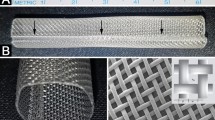Abstract
Objective
To evaluate the feasibility and possibility of wrapping ureter by a pedicled gastrocolic omentum flap combined with an artificial ureter external scaffold to prevent stoma stenosis in rabbit after ureterocutaneostomy.
Methods
Forty male New Zealand rabbits were involved in this study. For application of ureterocutaneostomy, the right ureter was wrapped by a pedicled gastrocolic omentum flap and combined with application of an artificial external scaffold, which served as experimental side. Traditional ureterocutaneostomy was applied in left ureter (control side). All rabbits were killed after 1 month, and the kidney, ureter and abdominal segment ureter were collected to study the morphological and pathological changes by using HE staining, Masson staining, immunohistochemistry staining and microvessel density (MVD) study.
Results
HE staining showed that renal medullary tubular dilatation, large number of collagen deposition, renal glomerular and renal tubular atrophy. Glomerular vascular leaves and interstitial fibrosis were detected in the kidney of control side. However, these abnormities in the kidney of experimental side were significantly alleviated compared to control side. The hydronephrosis and ureterectasia in the experimental side were dramatically attenuated compared to control side. Fibrosis in ureter around stoma and stoma stenosis were prevented by wrapping ureter by a pedicled gastrocolic omentum flap combined with an artificial external scaffold.
Conclusion
In this study, we have demonstrated that wrapping ureter by a pedicled gastrocolic omentum flap combined with an artificial external scaffold is capable of preventing stoma stenosis in rabbit after ureterocutaneostomy, which provided a new method and theoretical basis for clinical application in the future.






Similar content being viewed by others
References
Kozacioglu Z, Degirmenci T, Gunlusoy B, Ceylan Y, Minareci S (2013) Ureterocutaneostomy: for whom and when? Turk J Urol 39(3):143–146
Siegel R, Naishadham D, Jemal A (2013) Cancer statistics, 2013. CA Cancer J Clin 63(1):11–30
Hall MC, Chang SS, Dalbagni G, Pruthi RS, Seigne JD, Skinner EC, Wolf JS Jr, Schellhammer PF (2007) Guideline for the management of nonmuscle invasive bladder cancer (stages Ta, T1, and Tis): 2007 update. J Urol 178(6):2314–2330
Dall’Era MA, Cheng L, Pan CX (2012) Contemporary management of muscle-invasive bladder cancer. Expert Rev Anticancer Ther 12(7):941–950
Bagi P, Nordsten CB, Kehlet H (2016) Cystectomy for bladder cancer in Denmark during the 2006–2013 period. Dan Med J 63(4):A5217
Witjes JA, Comperat E, Cowan NC, De Santis M, Gakis G, Lebret T, Ribal MJ, Van der Heijden AG, Sherif A (2014) EAU guidelines on muscle-invasive and metastatic bladder cancer: summary of the 2013 guidelines. Eur Urol 65(4):778–792
Bricker EM (1950) Bladder substitution after pelvic evisceration. Surg Clin North Am 30(5):1511–1521
Pycha A, Comploj E, Martini T, Trenti E, Mian C, Lusuardi L, Lodde M, Mian M, Palermo S (2008) Comparison of complications in three incontinent urinary diversions. Eur Urol 54(4):825–832
Deliveliotis C, Papatsoris A, Chrisofos M, Dellis A, Liakouras C, Skolarikos A (2005) Urinary diversion in high-risk elderly patients: modified cutaneous ureterostomy or ileal conduit? Urology 66(2):299–304
Davila HH, Magee TR, Vernet D, Rajfer J, Gonzalez-Cadavid NF (2004) Gene transfer of inducible nitric oxide synthase complementary DNA regresses the fibrotic plaque in an animal model of Peyronie’s disease. Biol Reprod 71(5):1568–1577
Ferrini MG, Davila HH, Kovanecz I, Sanchez SP, Gonzalez-Cadavid NF, Rajfer J (2006) Vardenafil prevents fibrosis and loss of corporal smooth muscle that occurs after bilateral cavernosal nerve resection in the rat. Urology 68(2):429–435
Kovanecz I, Rambhatla A, Ferrini M, Vernet D, Sanchez S, Rajfer J, Gonzalez-Cadavid N (2008) Long-term continuous sildenafil treatment ameliorates corporal veno-occlusive dysfunction (CVOD) induced by cavernosal nerve resection in rats. Int J Impot Res 20(2):202–212
Vernet D, Ferrini MG, Valente EG, Magee TR, Bou-Gharios G, Rajfer J, Gonzalez-Cadavid NF (2002) Effect of nitric oxide on the differentiation of fibroblasts into myofibroblasts in the Peyronie’s fibrotic plaque and in its rat model. Nitric Oxide 7(4):262–276
Weidner N, Folkman J, Pozza F, Bevilacqua P, Allred EN, Moore DH, Meli S, Gasparini G (1992) Tumor angiogenesis: a new significant and independent prognostic indicator in early-stage breast carcinoma. J Natl Cancer Inst 84(24):1875–1887
Chitale SV, Chitale VR (2006) Bilateral ureterocutaneostomy with modified stoma: long-term follow-up. World J Urol 24(2):220–223
Arvind NK, Singh O, Ali Q, Singh J, Gupta SS, Sahay S (2014) Laparoscopic ureterolysis and omental wrapping in patients with retroperitoneal fibrosis and obstructive uropathy: a single-center experience. J Laparoendoscopic Adv Surg Tech Part A 24(3):159–164
Wang G, Han G, Ren Y, Cheng Y, Xu Y, Zhao Y, Zhang J, Lu C (2014) Clinical effects of pedicled omentum covering and wrapping the ureteral anastomosis to prevent ureteral anastomotic leakage after surgery of abdominal and pelvic tumors. Chin J Oncol 36(3):232–235
Acknowledgements
This work was supported by grant from National Natural Science Foundation of China (No. 81300475 to Jiaming Wen).
Author information
Authors and Affiliations
Corresponding author
Ethics declarations
Conflict of interest
The authors declare no conflict of interest.
Ethical approval
All rabbits were maintained and housed in accordance with NIH guidelines and with the approval of the Animal Care and Use Committee at the Second Affiliated Hospital of Zhejiang University.
Rights and permissions
About this article
Cite this article
Zhang, S., Gao, F., Xue, C. et al. The application of wrapping ureter by a pedicled gastrocolic omentum flap combined with an artificial external scaffold to prevent stoma stenosis in rabbit after ureterocutaneostomy. Int Urol Nephrol 49, 255–261 (2017). https://doi.org/10.1007/s11255-016-1475-9
Received:
Accepted:
Published:
Issue Date:
DOI: https://doi.org/10.1007/s11255-016-1475-9




